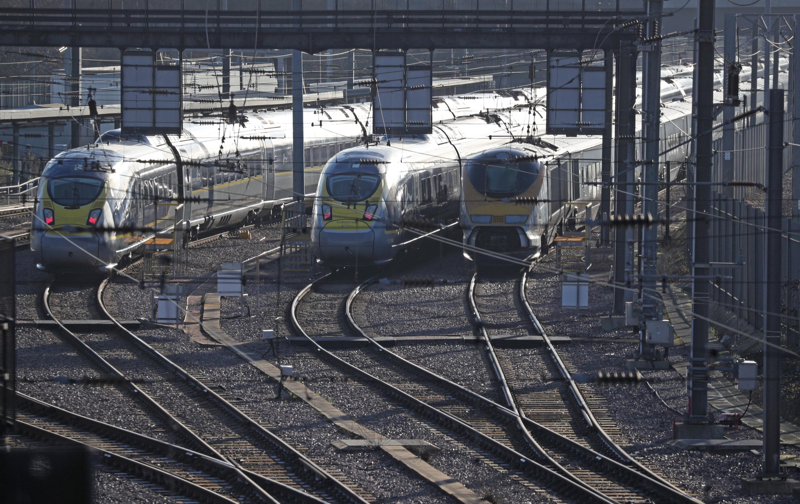
The report examining capacity at Temple Mills International Depot (TMI) has found it could accommodate some additional trains if needed.

The report examining capacity at Temple Mills International Depot (TMI) has found it could accommodate some additional trains if needed.
The Office of Rail and Road (ORR) appointed Ipex to study the depot as three open access operators look to challenge Eurostar on international services.
Its report has found that changes around the site could improve capacity. These include operational changes as well as adding new facilities to unlock additional space.
Evolyn and Virgin submitted Section 17 depot access applications last year, while Gemini Trains announced its intention to use TMI last week. All of have said the report supports their arguments.
Eurostar, which leases the depot from the Department for Transport, has insisted there isn’t space at the site for a second operator.
Ipex’s, published on March 31, said some capacity could be accessed without any changes to operational capacity, while the rest could come through changes to operational practices, although that doesn’t include adaptations to ensure compatibility with different types of train.
The report found: “Some latent capacity can be accessed without changing current operational practices at Temple Mills. However, to access the full extent of the identified latent maintenance shed capacity, changes to existing operational practices are necessary.”
Ipex said TMI has a normal capacity of 15 sets, with six-ten of Eurostar’s operational fleet regularly occupying the site with a decommissioned Class 373 occupying a reception road “indefinitely”. The report said the observations made demonstrated that the depot is occasionally getting close to maximum normal capacity, but with reception and lavatory discharge areas (LDA) roads were used, then the occupancy would be “well within the maximum of 15 sets”.
“In its current use, the latent capacity (maximum number of additional sets) at Temple Mills varies between four-eight sets, over a 24-hour period,” the report said. “The quantity increases to five-nine sets with the removal of one decommissioned set from the depot.”
It also found that there was unused capacity to accept more sets into TMI. The report found the average arrival rate was 0.5 per hour, with spare capacity of 0.8 per hour identified without disrupting the normal flow of lavatory disposal and wash plant roads, even during peak hours.
Under current operational practices the peak arrival rate is three sets per hour, Ipex said, with the impact of the depot’s maximum normal capacity needed to be considered before changes are made.
Investment and an assessment into process changes could also be needed to enable changes in the maintenance shed. The report found there were typically two free roads during the day and one at night.
However, Ipex went on to say it observed Eurostar occasionally using “more shed roads than is determined by the maintenance plan”.
It continued: “Sets may continue to occupy the shed following completion of maintenance until their departure which is due to the small ratio of stabling roads to shed roads at Temple Mills (there are only three stabling roads compared to eight shed roads), and that the reception and LDA roads are not currently used under current operation practices for stabling or Set departures.
“The full extent of the identified Latent Maintenance Shed Capacity could be realised if tasks such as interior cleaning, interior repairs, and driver preparation which are occasionally performed in the shed, were always completed elsewhere.”
While Ipex could not confirm the amount of additional time sets spend in the shed once maintenance has finished, the firm said it was “evident that using the reception roads would provide an alternative location for these activities and therefore unlock more shed capacity”.
Six options were laid out to improve capacity. These included upgrading capability of roads containing lavatory facilities to either double the rate sets are put through or enable light maintenance and further train preparation to be carried out, upgrading four reception roads or three stabling roads for cleaning, preparation and light maintenance, improve walking routes and staff facilities around TMI so work can take place around the site, and remove the decommissioned Class 373s.
Ipex said there are four half-sets that have been at the depot since 2019 that are used as a source of spares for the eight operational ‘373s’.
“For Eurostar it is normal practice, but it is not considered industry practice. Depot space would typically be given preferentially to stabling and maintenance of operational sets,” Ipex reported.
The report did not consider costs associated with options to enhance capacity, while it said that changes as a result of potential improvement options would include driver resource to accommodate extra depot movements, efficiency or reliability impacts and safety implications.
Stakeholders now have until April 28 to submit evidence they believe supports or could change the findings before ORR’s final concludes are published.
Login to continue reading
Or register with RAIL to keep up-to-date with the latest news, insight and opinion.


















Coling50 - 02/04/2025 15:42
I’m sorry but their assumptions seem to have been made without full observation of how the depot works in reality. The 374s for example are no where near as reliable as it was claimed by Siemens. They tend to be in the shed because they need to be in the shed. This idea that they are merely stabled there awaiting departure time is not the reality.